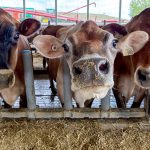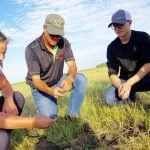Canada’s first export of a rare Mammoth Jack donkey to New Zealand is one way Sybil and Carl Sewell hope to build interest in a rare breed.
It took the Leslieville, Alta., couple nearly a year of phone calls and e-mails to close the deal that sent the two-year-old female, Windy Ridge Black Mariah, to New Zealand.
The jennet arrived by plane after four weeks of quarantine in Canada and the United States following an 18 hour trip that included 17 horses and donkeys.
Read Also

Farm Credit Canada partners with major Toronto innovation hub
A FCC parntership with MaRS Discovery District aims to solve technology problems in food supply chains.
Its new home is with Bryan and Jenny Claussen, who breed the large donkeys on New Zealand’s North Island. A further two week quarantine was imposed at a special facility near Auckland.
“Claussens are building up a herd of Mammoths and they are trying to preserve Mammoth Jacks,” said Sybil Sewell, of Windy Ridge Farm Donkeys.
“They received lots of pictures from the time she was a baby on the ground until she left on Feb. 13,” she said.
The Sewell family has raised this breed for 30 years and has been exporting registered animals to the United States since 1982.
They bought their first donkey in 1970 while they were living in Ontario. They started breeding donkeys in 1971 and continued the business when they moved to Alberta in 1981.
Their donkeys have gone into breeding programs as well as to customers looking for driving teams, riding or packing. There is also interest in using the large male donkeys to sire mules for riding and driving.
One of their donkeys ended up in Colorado, where the owner enters pack burro races that retrace the steps of the early prospectors who climbed into the mountains in search of gold and then raced back to the nearest land office to stake their claims.
The American Rare Breeds Conservancy has placed the American Mammoth Jack donkey on its threatened list, meaning there are fewer than 1,000 annual registrations in the U.S. and an estimated global population of less than 5,000.
The breed was developed from large European donkeys imported from Spain and Malta to the U.S. by U.S. president George Washington in 1785.
The donkeys are generally black in colour.
A male Mammoth Jack stands at least 56 inches high at the withers while the females are 54 inches high. They achieve their full height at four or five years.
A standard sized donkey is higher than 36 inches and less than 48 inches at the withers. A large standard donkey jack is taller than 48 inches but less than 56 inches.















